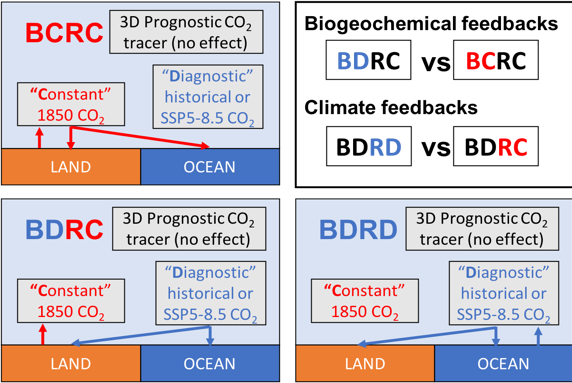v1 BGC and Energy
Uptake of CO2 by land and ocean ecosystems determines how much atmospheric CO2 concentrations increase due to emissions from combustion and other human activities. In turn, the efficiency of ecosystems in sequestering carbon responds to changes in climate and CO2 concentration.
The v1 biogeochemistry experiment seeks to answer this question:
V1 SCIENTIFIC QUESTION:
What are the effects of nitrogen and phosphorous on climate-biogeochemistry interactions, and how sensitive are these interactions to model structural uncertainty?

E3SM v1 BGC experiment design, indicating whether biogeochemical CO2 is constant (downward red arrows) or diagnostic (downward blue arrows) and whether radiative CO2 is constant (upward red arrows) or diagnostic (upward blue arrows) in each of the three configurations
The experiment does this by (1) performing simulations with and without representation of phosphorus limitation to examine its impacts on carbon–climate interactions; and (2) performing simulations using both the ECA and CTC approaches coupled with ELM, with carbon-nitrogen-phosphorus (ELMv1-CTC-CNP and ELMv1-ECA-CNP), two terrestrial biogeochemistry representations of allocation, stoichiometry, photosynthesis, and nutrient competition developed in Phase I. Simulations will be performed using different couplings of CO2 to separate the radiative and biogeochemical climate impacts (see figure); these simulations also comprise a subset of the Coupled Climate-Carbon Cycle Model Intercomparison (C4MIP) experiments (Jones et al., 2016). Except for the inclusion of active land and ocean biogeochemistry, this coupled model configuration is the same as the LR configuration used in the DECK simulations, so this effort leverages the successful development and tuning of the LR model for the water cycle experiments.
Additionally, considerable development was carried out in Phase I to enable ocean biogeochemistry in the new MPAS-O and MPAS-SI models. The model has been spun up to a pre-industrial equilibrium initial state in a multi-step process, in which land and ocean biogeochemical systems have been spun up separately, followed by a period of fully-coupled spin-up.
The project anticipates completing the planned CO2 coupling experiments utilizing the carbon-nitrogen-phosphorus nutrient limitation configurations before the end of Phase I (June 2018). In Phase II as part of the core activity, the project plans to execute the same suite of simulations in a configuration without phosphorus limitation, in order to isolate its effects.
CAMPAIGN UPDATES:


